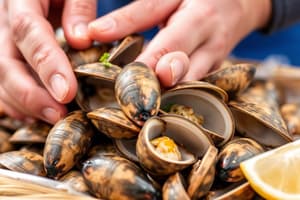Podcast
Questions and Answers
Sinupalliate bivalves have a distinct indentation called a pallial sinus in the anterior part of the pallial line.
Sinupalliate bivalves have a distinct indentation called a pallial sinus in the anterior part of the pallial line.
False (B)
All bivalves are burrowers.
All bivalves are burrowers.
False (B)
Pectens are capable of swimming by rapidly flapping their valves to escape from predators.
Pectens are capable of swimming by rapidly flapping their valves to escape from predators.
True (A)
Bivalves are more abundant in Palaeozoic rocks than in Mesozoic and Cenozoic rocks.
Bivalves are more abundant in Palaeozoic rocks than in Mesozoic and Cenozoic rocks.
The taxodont type of dentition has two or three large teeth with grooves on the sides of each tooth.
The taxodont type of dentition has two or three large teeth with grooves on the sides of each tooth.
Isodont bivalves have two large teeth with a resilifer between them.
Isodont bivalves have two large teeth with a resilifer between them.
Bivalves have a distinct head with eyes and mouthparts.
Bivalves have a distinct head with eyes and mouthparts.
The ligament in bivalves forces the shell to close.
The ligament in bivalves forces the shell to close.
Bivalves have a radula for feeding.
Bivalves have a radula for feeding.
Bivalves are also known as Pelecypoda or Lamellibranchia.
Bivalves are also known as Pelecypoda or Lamellibranchia.
Bivalves have a dorsal foot for swimming.
Bivalves have a dorsal foot for swimming.
The valves of bivalves are united by a rigid hinge.
The valves of bivalves are united by a rigid hinge.
Bivalvia is a class of molluscs that have a cap-shaped shell with apex subcentral or curved forwards.
Bivalvia is a class of molluscs that have a cap-shaped shell with apex subcentral or curved forwards.
Bivalvia is one of the three classes of molluscs with abundant fossil records.
Bivalvia is one of the three classes of molluscs with abundant fossil records.
All molluscs in the class Bivalvia live on land.
All molluscs in the class Bivalvia live on land.
Bivalvia is a class of molluscs that consists of segmented animals.
Bivalvia is a class of molluscs that consists of segmented animals.
The shell or pair of shells in Bivalvia is used for protection and support.
The shell or pair of shells in Bivalvia is used for protection and support.
Bivalvia is a class of molluscs that is only found in fresh water.
Bivalvia is a class of molluscs that is only found in fresh water.
Flashcards are hidden until you start studying




